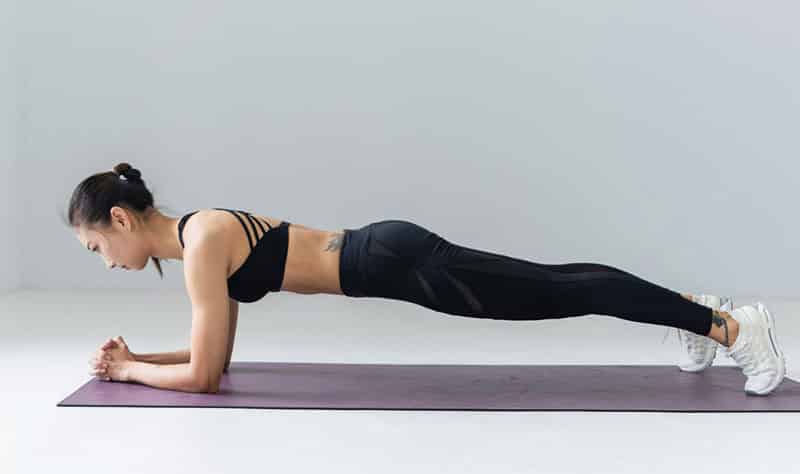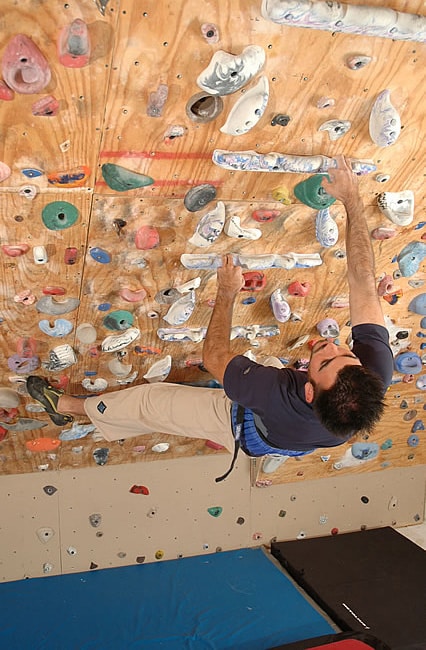Isometric exercises can help climbers overcome training plateaus by achieving strength gains via new avenues that offer their bodies a different platform to work from. Learn more about isometric training, and six effective isometric training exercises for climbers.
(This article was originally published in December of 2019, but isometrics are still low-hanging fruit for most climbers in search of their next strength training pursuit!)
Most advanced climbers have discovered that significant strength gains are harder and harder to come by as you power through the grades. Plateaus, then, become increasingly common as climbers continue to develop their skills and strengths. Overcoming those plateaus and achieving physical breakthroughs that pay off on the rock may elude you without a conscious effort to keep your body guessing.
The key to breaking new ground is “tricking” your body with new exercises and regimens that impart a training stimulus that the body is not accustomed to. Simply flogging yourself with more of the same—a surprisingly common training theme—is usually a pretty ineffective approach (unless you enjoy nagging overuse injuries). If you want to climb harder and dodge the injury bullet more easily, then you need to be smarter about the exercises you perform in the name of improving your climbing.
One such exercise that you can introduce into your training for novel stimulus is a routine called Long-Duration Isometrics (LDI). It’s a proven method of shocking the muscles into navigating sticking points and shattering long-held limits in strength.
Long-Duration Isometric Training Benefits
Isometrics are static contractions—that is, when muscles contract without actually moving anything. Isometric contractions are a big part of the climbing process, as your muscles hold your body in place with every grip of the rock and lock-off arm position. When climbing, you only maintain this isometric contract for a few seconds before moving quickly to the next hard move.
Long-duration isometric exercises, however, involve holding a strenuous position for 30 seconds or more. While this training method isn’t very specific to the way you climb (unless make a habit of hanging out at a crux move until you pump out and fall!), it is an excellent way to trigger adaptations in the neuromuscular system.
Research confirms that a maximal isometric contraction can recruit more motor units and muscle fibers than either concentric and eccentric action. Long-duration isometric exercises recruit higher-threshold fibers as their lower-threshold counterparts fatigue. So, while holding an open-hand grip or lock-off for just a few seconds will call only a small number of motor units into play, holding an isometric contraction for 30 seconds, 60 seconds, or longer will recruit the less-frequently used high-threshold fibers into play. These are the exact fibers that lead to a higher level of muscle function. What’s more, LDI may improve neural programming (a.k.a. synchronization between motor units) and strengthen tendons, thus increasing muscle efficiency and endurance.
An important caveat to long-duration isometric training is that the resulting neurological enhancements and strength gains are limited to the grips and angles actively training. This means that you’ll want to target multiple grip positions (such as the open hand, pinch, and half crimp) as well as lock-offs on both vertical and steep planes (which fire the back and shoulder muscles a little differently). It’s important to train as closely as possible to what you want to recruit on the wall.
Detailed below are six long-duration isometric exercises that I’ve found effective. Think of these as a starting point for your own creativity, too. Maximum LDI sets should be performed at the end of your workout, although a single “short” LDI set (30 – 60 seconds total) can effectively activate the muscles as part of your pre-climb warm-up routine. For advanced climbers, I suggest holding each LDI for one to three minutes. Begin by performing one set of each exercise per workout, and then add a second set when you feel able. Make sure to rest for five minutes between sets. Doing more than two sets will provide little added benefit while creating greater neurological and metabolic fatigue from which to recover.
6 Effective Long-Duration Isometric Exercises:
- Hanging lock-off: Using a pull-up bar or the bucket holds on a hangboard, hold a lock-off in the top or middle position (photo above) for as long as possible. Do two sets, one each with narrow and wide grip. (Do no lock-offs if you have a history of elbow pain.)
- Steep-wall twist-lock: Using a juggy handhold and good footholds, hold a twist-lock position with the low hand pulled in tight to your chest while the reaching hand lightly grips a smaller hold above. Concentrate on maintaining a tight core and a solid twist-lock for as long as possible (30 seconds is challenging…60+ seconds is hard!).

- Dumbbell wrist curl: While hardly climbing-specific, this exercise works all the finger- and wrist-flexing muscles in a very intense way. Using a moderate-weight dumbbell (10 – 20 pounds for gals, and 25 – 35 pounds for guys), curl the dumbbells up from the open-hand to the closed-hand position, and then maintain a tight grip on the dumbbells as you curl your palms upward as far as possible. Holding this position for 1 to 3 minutes really fires up the forearm muscles. I’ve found this to be an excellent pre-climbing warm-up activity as well (to help work through the flash pump phase).
- Dumbbell reverse wrist curl: This is a great way to train the important but often overlooked finger/wrist extensor muscle. With your forearm in a stable, horizontal position (resting on the edge of a table or similar), hold a 10- to 20-pound dumbbell with a palm-down grip. Now curl the dumbbell up to the top position (wrist extension) and maintain this position for as long as possible.
- Floor Plank: This popular floor exercise is often performed with some positional movement as part of a larger core-training program. The goal here is to hold a static plank position with good technique (see photo below) for as long as possible. Three minutes is challenging, and five minutes is downright hard!
A word of warning: As with any training practice, discontinue long-duration isometrics if you develop any pain in the fingers, elbows, or shoulders. If you are currently nursing a finger or arm injury, favor low-load Blood Flow Restriction training over LDI. You can support connective tissue healing/remodeling with this proven training-nutritional intervention.
Related Articles:
- Weighted Pull-Up Training for Increased Strength, Power and Endurance
- Maximum Strength Training for Climbers
- Advanced Hangboard Techniques for Developing Finger Strength
- Develop One-Arm and Lock-Off Strength with Uneven-Grip Pull-Ups
- 4 Minute Plank Training for Increased Core Strength and Endurance
Copyright © 2000–2023 Eric J. Hörst | All Rights Reserved.












